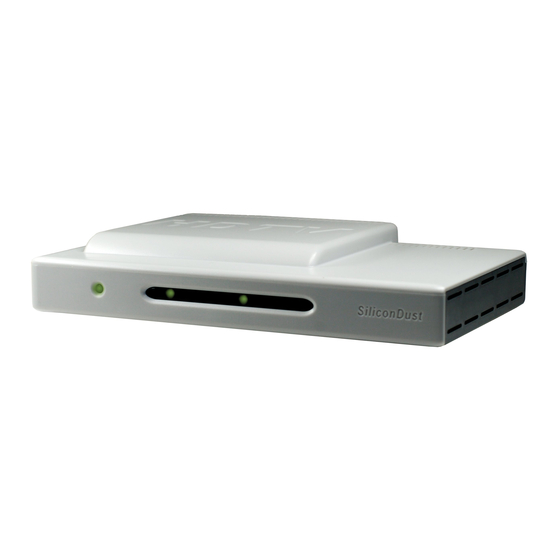Table of Contents
Advertisement
Quick Links
Advertisement
Table of Contents

Summary of Contents for SiliconDust HDHomeRun
- Page 1 HDHomeRun Installation Instructions (20081228)
- Page 2 9. Tuner0 5. IR Receiver Power LED: The power LED will remain lit at all times the HDHomeRun is connected to power. Network LED: The network LED indicates network connectivity; the LED will flash while the HDHomeRun acquires an IP address over DHCP and then will remain lit.
- Page 3 Antenna users: The typical antenna configuration is: Antenna -> Amplifier -> 4-way Splitter -> TVs/Devices For larger antenna based systems: Antenna -> Amplifier -> 2-way Splitter -> 4-way Splitter -> TVs/Devices -> 4-way Splitter -> TVs/Devices It is generally a good idea to balance the splitter layout, as shown above. A balanced configuration means all devices go through the same configuration of splitters back to the antenna;...
- Page 4 Alternatively the HDHomeRun can be connected directly to a PC or laptop network interface using the supplied network cable; there is no need for a cross-over cable. Power connection: Connect the 5V power adapter supplied with the HDHomeRun to the power connector on the back of the HDHomeRun.
- Page 5 HDHomeRun Setup will automatically detect the HDHomeRun device(s) on the network. • If the HDHomeRun is connected directly to the PC rather than the network it may take a • few minutes before the HDHomeRun can be detected. Wait until the HDHomeRun link LED stops flashing and click Retry.
- Page 6 Vista Home Premium and Vista Ultimate include Windows Media Center. TotalMedia is provided with the HDHomeRun for use on other versions of Windows. The most up to date instructions for each application can be found of the Silicondust website: http://www.silicondust.com/hdhomerun/instructions...

Need help?
Do you have a question about the HDHomeRun and is the answer not in the manual?
Questions and answers